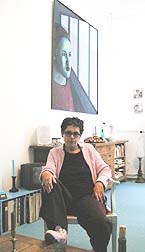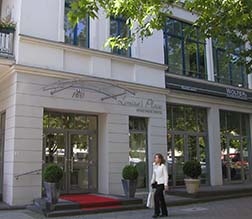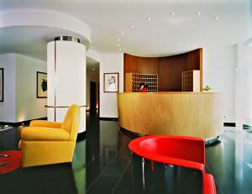Protest at Rosenstrasse by non-Jewish women saved their Jewish husbands and sons in rare case of open defiance of the Nazis
By Lucy Komisar
The first time I viewed the Rosenstrasse sculptures a couple of years ago, I was stunned. A Berlin painter, Sarah Haffner, had urged me to see them. She told me how East German sculptor Ingeborg Hunzinger, an artistic refugee from the Nazis, had struggled to chisel the pieces in the mid-80s when she was already 70 years old, to honor women resisters against the Nazis.
The group of reddish pink sculptures is called Block der Frauen, the block of women. The works were finished after German unification, and in 1995, the German government mounted them in a small park just off Karl Liebknechtstrasse in former East Berlin.
Hunzinger‘s dramatic art commemorates an extraordinary event that occurred at that site in February 1943. At that time, the Nazis had rounded up some 2500 Jewish men and boys, the husbands and sons of non-Jewish women, and imprisoned them at Rosenstrasse 2-4, the Jewish Community Center.
Until that time, Jews in mixed families had escaped deportation to death camps. Many, instead, had been sent to forced labor, and wives were pressured to divorce such husbands. Some did, but others remained loyal. In 1943, as part of the Nazis “Final Roundup” of over 60,000 Berlin Jews, they arrested the free sons or husbands of Aryan women and moved others from factories to gather them for deportation to death.
The Nazis wanted to keep the Rosenstrasse detention place secret, but the women found out where the men had been taken and converged there. The first day there were 600. A solidarity emerged, and a spontaneous demonstration erupted as they shouted, Give us our husbands back. Other family members joined them.
It was the first time there had been a public demonstration against the Nazis. The protests grew to include as many as 6,000 people over the week. The police dispersed them, warning they would shoot, but the women regrouped, without leaders or weapons. The guards pointed machine guns at them and threatened to open fire. The women held their ground and shouted, “Murderer, murderer, murderer!”
After a week, propagandist Joseph Goebbels, who indicated in his diary that he was worried about the protest‘s public relations impact in Germany and abroad, ordered that the Jews with Aryan spouses or parents be released. Twenty-five who were freed had already been sent to Auschwitz! And then the event seemed to vanish from history.
Why didn‘t we know about this? Why is it still generally believed that no one could challenge the Nazis and live?

Sarah Haffner said, “This happened in 1943, and for 40 years nothing had been said about it. Only when Ingeborg Hunzinger started doing this marvelous sculpture in the 1980s did people begin to talk about this. When people first started talking about it, we wondered why this had not been discovered before. Germany was in shame because there was so little opposition to the Nazis, and this was a case where there was successful opposition.”
What were the reasons? She suggested it was “exactly because it was successful and showed that one could actually oppose this government when people had been saying that you couldn‘t do anything, because you would land in concentration camps. The other reason was that it was women protesting. Why did the women manage and not the men?” She added, “I went to see it yesterday with two English friends. The stone is a reddish color and has some little green moss on it now, as if it were breathing.”
Among the scenes depicted and the slogans written on the sculptures are “Forced labor and Mutual support, Give us our husbands back, The Power of civil disobedience, The power of love, Overcome the power of dictatorship, and Women stood here to overcome death.” One block of stone shows different times at which the Jewish people experienced expulsion: The Garden of Eden, The Babylonian Exile, and, represented by a man with a broken violin, the expulsion of Jews from German culture during Nazism.
In 2003, another woman, German director Margarethe von Trotta, made the film, “Rosenstrasse,” to tell the heroic women‘s story.
Ingeborg Hunzinger celebrated her 90th birthday in February 2005.
If you go
The easiest way to find the sculptures is from the wide thoroughfare appropriately named after the anti-fascist Karl Liebknecht. Turn in to Rosenstrasse at the kiosk across the street from the Marienkirche and City Hall and just past the art museums.
More information about Rosenstrasse sculptures.
Hotels
We stayed in two very different style hotels, Louisa‘s Place on the Kurfurstendamm in former West Berlin and the Art‘otel in the former East.

Louisa‘s Place, named after the Prussian queen of the late 19th century, was built in 1904 as an apartment house and recently opened as an apartment hotel in April 2004. The classic building has 47 suites with full kitchens and guests can use a clothes washing machine. The suites are spacious and smartly decorated – and serviceable. At the fine wood desk, you‘ll find a free Ethernet connection to the internet.
Lunch and dinner are available downstairs at Wolters, whose chef Rainer Wolter is famous for his new German cuisine. (opened daily except Sunday). There are elegant rooms for small meeting and private parties. The library has wood walls from France. Guests can get massages and facials, use the pool, fitness machines, and two saunas, one at 90 degrees, another at 60. The staff is so accommodating, they will even get your groceries.
Louisa‘s Place
Kurfürstendamm 160
D-10709 Berlin
Tel 49 (0)30 631 030
Fax 49 (0)30 631 03 100
In the US: 800 650-8018
info@louisas-place.de

The Art‘otel Mitte is located very near the major East Berlin art museums. Each hotel of the chain is dedicated to a prominent contemporary artist. This one features German painter Georg Baselitz, whose works appear throughout the building. We had a small serviceable white box of a room with a bright red plastic leather chair and night table shelf.
Breakfast was excellent and the dining room cheery red, blue and yellow; the bar sported a logo like a Campbell‘s soup can. Most of the clientele are people in their 30s and 40s, the sort who (as one did) carry literary reviews under their arms.
Art‘otel
Berlin Mitte
Wallstrasse 70-73
D-10179 Berlin
Tel 49 (0)30 240-620
Fax 49 (0)30 240 62 222
aobminfo@artotels.de
Getting there
Train travel in Germany is excellent, with frequent and fast connections all over the country. If you‘re going to several cities, or to other countries, a good way to save money and time is with a railpass from RailEurope. There are many railpass options available, for one, two, three or more countries. Go to Rail Europe’s web site (or call a reservation agent) to decide whether your trip is best done with point-to-point tickets or a pass or combination of the two. Passes are sold only to non-European residents. RailEurope or 888-382-7245.
The best guidebooks
Germany, DK Eyewitness Travel Guides
This takes you to each site and bullets key sites, with mini-photos on each page and the opening times, costs and other relevant information. Major museums and locations get diagrams, with extensive details about the key attractions. Suggested hotels and restaurants. Good maps.
Germany, Insight Guides, Langenscheidt Publishers
This offers more detail about the history, art and economy as it moves through the city in a narrative style. Useful information is supplied for key sites. Suggested hotels and restaurants. Good maps.
Photos by Lucy Komisar
Photo of Art‘otel from hotel website


Thanks for this, Lucy. Always wondered why nothing much is written about Germans who fought Nazism in some way. The women you write about were married or related to Jews, but what about the thousands of Aryans who resisted and fought Nazism? There was a huge underground to help Jews escape, but so little is known of this. As a US citizen with some German ancestry, I am especially sad to think that Germany, a nation which produced so many great women and men, had not the brains or the courage to overthrow these mad men. Thousands of US soldiers came home with German brides … further making one wonder. Shouldn’t we want this known by everyone?
LK: The women described in the article were all Aryans, the non-Jewish wives of Jewish men.
Martha Dodd, daughter of the ambassador to Germany, wrote several books, including “Through Embassy Eyes” right after returning to the US in 1939. “Through Embassy Eyes” is her notes on the four years spent in Germany during that time. She has many interesting insights.
Bella Fromme was another courageous woman living in Berlin at that same time. Her book “Blood and Banquets” is taken from her secret diaries that she managed to smuggle out in 1938.
Margaret Harnack was an American married to a German economist who was a heroic spy and so infuriated Hitler with her action, that he personally supervised her execution. “The Red Orchestra” is one of the books that talks about her.